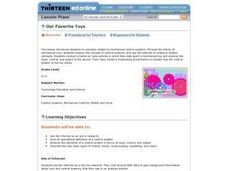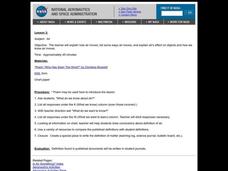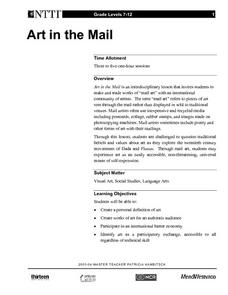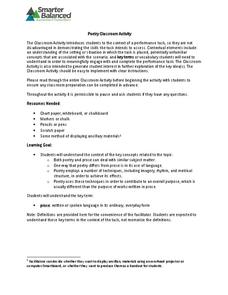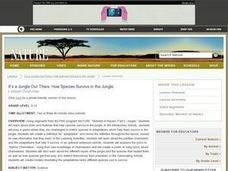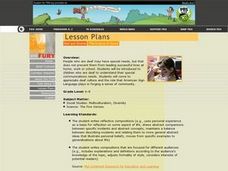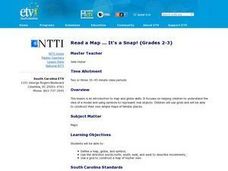Curated OER
Are You One of Us?
Students investigate how scientists sort and classify organisms. In this sorting and classifying lesson, students examine what systematics are as tools that scientists use. They examine images of invertebrates and sort them while stating...
Curated OER
Symmetry with Manipulatives
First graders investigate symmetry in patterns by utilizing unifix cubes. In this pattern lesson, 1st graders practice creating patterns that are perfectly symmetrical no matter which way it's looked at. Students utilize...
Curated OER
TIN CAN TREAT
Students conduct an experiment where they will change a liquid dairy product into a solid. They review the definitions of liquids and solids. Students are given an example of each. They are divided into groups of four, each group is...
Curated OER
Investigating and Using Biomass Gases
Students examine the definitions of biomas gasification and generate their own biomass gas. In this renewable energy lesson students collect gases and roast a marshmallow.
Curated OER
Our Favorite Toys
Young scholars give an operational definition of a control system. They analyze the elements of a control system in terms of input, control, and output and describe the four basic types of motion: linear, reciprocating, oscillating, and...
Curated OER
Salat: Prayer in Muslim Life
Students examine the meaning of prayer and provide their own definitions. They watch a video about Muslim prayer, discuss a fact sheet about it, and break into discussion groups. Students write about their own traditions and customs...
Curated OER
Air
Students complete a KWL chart on what they know about air. Reading a poem, they compare published definitions of air with the ones they created. They write the definition of air on a bullentin board. They also write their observations in...
Curated OER
Be Sharp and Never Flat
An outstanding lesson on music awaits your young composers! They learn about patterns found in music, the different sections of an orchestra, and see the differences between musicians and a composer. Excellent streamed videos and good...
Curated OER
You Are What You Eat
Youngsters listen to the story of Gregory the Terrible Eater and write a similar story using the same pattern. In the new book, Herman is requested to eat things that are nouns. They must supply the correct part of speech for the class...
Curated OER
Expert Estimators
A rich and well-designed lesson on estimation is here for you. The lesson utilizes a video; ITV Series: The Eddie Files 'Estimation: Going to the Dogs,' along with many websites. Several fantastic learning activities are...
Curated OER
Terrific Traveling Tour
Fifth graders discover the career of a museum curator as they assemble mock museum displays and gather information on famous works of art. The lesson is very complete and includes lesson extensions, resource links, and curricular...
Sargent Art
Picasso and Beyond!
After reviewing the life and art of Pablo Picasso, learners set out to create abstract, cubist, relief portraits. They'll draw, color, paint, and cut out portraits just like the ones Picasso created. The lesson is extremely well written...
Curated OER
Blending into Good Speech
Your class can increase their production of the target phoneme /sh/ through the use of video, the Internet, and hands-on activities listed here. Sound out the phoneme altogether, then model words that include /sh/ at the beginning....
Curated OER
Art in the Mail
The "mail art" phenomena was started back in the 20's with the Dada and Fluxus art movements and revitalized in the 60's. The principle of mail art, is free exchange and artistic expression. Learners study these facts and then create...
Science Friday
Mineral Madness
Science does not need to be as hard as a rock. Pupils test 10 different minerals to determine their properties. The learners observe luster, streak, hardness, and fluorescence for each specimen. Afterwards, they compare and contrast the...
Science Friday
Termite Symbiosis
What happens to the wood a termite eats? Pupils learn about the three types of symbiosis with pictures of symbiotic pairs. Afterward, they determine whether there is a symbiotic relationship with a termite by dissecting termites and...
Science Friday
Make a Speaker
Make science come in loud and clear. Pupils learn about how a speaker works by building one. The scholars first learn about electromagnetic fields by building an electromagnet. Using that knowledge, they build a crude speaker using a...
Smarter Balanced
Poetry
How does poetry differ from other forms of writing? Class members view two writing samples, decide which one is a poem, and then identify the criteria they used to distinguish between the two samples.
Curated OER
Euthyphro, Apology, Crito, and Phaedo - Essay Questions
In this online interactive reading comprehension instructional activity, students respond to 35 multiple choice questions about Plato's "Euthyphro," "Apology," "Crito," and "Phaedo."
Curated OER
It's a Jungle Out There: How Species Survive in the Jungle
Students investigate the different adaptation and skills of jungle species. In this ecology lesson, students play an interactive online game where they match species with their adaptation. They research about a specific adaptation and...
Curated OER
What is a Friend? A Multimedia Approach to Comprehension
First graders identify and discuss the characteristics of a good friend. They read the book "Just My Friend" by Mercer Mayer, and watch the videos "My Wet Pet" and "The Berenstein Bears: Road Race." Students identify the friend...
Curated OER
Deaf and Diverse
Students examine deaf culture and the role that American Sign Language plays in forging a sense of community.
Curated OER
The Sense of Hearing
High schoolers study the cycle of how we listen and hear our own speech. They examine sound waves, and the role of the nervous system in hearing. They investigate the cues besides lipreading that deaf people rely on for comprehension.
Curated OER
Read a Map ... It's a Snap!
Students are introduced to map and globe skills. They use grids and are able to construct their own simple maps of familiar places. Students are able to define a map, globe, and symbol and use the direction words north, south, east,...






